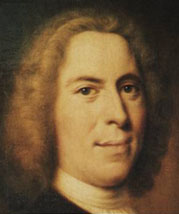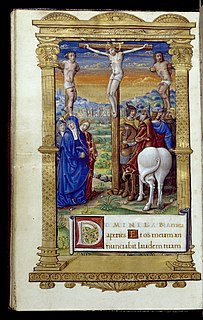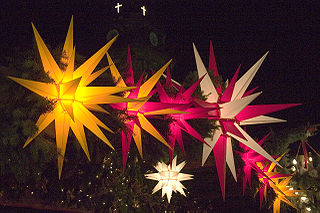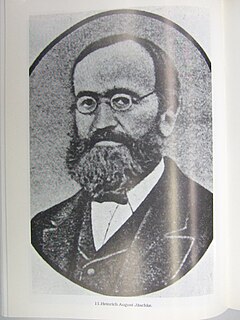
Nikolaus Ludwig, Reichsgraf von Zinzendorf und Pottendorf was a German religious and social reformer, bishop of the Moravian Church, founder of the Herrnhuter Brüdergemeine, Christian mission pioneer and a major figure of 18th century Protestantism.

Lauds is a canonical hour of the Divine office. In the Roman Rite Liturgy of the Hours it is one of the major hours, usually held after Matins, in the early morning hours.

Herrnhut(listen) is an Upper Lusatian town in the Görlitz district in Saxony, Germany, known for the community of the Moravian Church established by Nicolas Ludwig, Count von Zinzendorf in 1722.

The Moravian Church, or the Moravian Brethren, formally called the Unitas Fratrum, known in German as the [Herrnhuter] Brüdergemeine [sic], is one of the oldest Protestant denominations in the world, dating back to the Bohemian Reformation of the 15th century and the Unity of the Brethren founded in the Kingdom of Bohemia.

A lectionary is a book or listing that contains a collection of scripture readings appointed for Christian or Judaic worship on a given day or occasion. There are sub-types such as a "gospel lectionary" or evangeliary, and an epistolary with the readings from the New Testament Epistles.
The Revised Common Lectionary is a lectionary of readings or pericopes from the Bible for use in Christian worship, making provision for the liturgical year with its pattern of observances of festivals and seasons. It was preceded by the Common Lectionary, assembled in 1983, itself preceded by the COCU Lectionary, published in 1974 by the Consultation on Church Union (COCU). This lectionary was derived from various Protestant lectionaries in current use, which in turn were based on the 1969 Ordo Lectionum Missae, a three-year lectionary produced by the Roman Catholic Church following the reforms of the Second Vatican Council.

August Gottlieb Spangenberg was a German theologian and minister, and a bishop of the Moravian Brethren. As successor of Count Nicolaus Ludwig Zinzendorf, he helped develop international missions, as well as stabilize the theology and organization of the German Moravian Church.
Hosanna is a liturgical word in Judaism and Christianity.

Perpetual prayer is the Christian practice of continuous prayer carried out by a group.

God's Acre is a churchyard, specifically the burial ground. The word comes from the German Gottesacker, an ancient designation for a burial ground. The use of "Acre" is related to, but not derived from the unit of measurement and can be of any size. In the early 17th century the term was used as a translation of the German, but by the end of the century it was accepted as an English term.

Sunrise service is a worship service on Easter Sunday practiced by some Christian denominations, such as the Moravian Church.

A Moravian star is an illuminated Advent, Christmas, or Epiphany decoration popular in Germany and in places in Europe and America where there are Moravian congregations, notably the Lehigh Valley of Pennsylvania and the area surrounding Winston-Salem, North Carolina. The stars take their English name from the Moravian Church, originating in Moravia. In Germany, they are known as Herrnhut stars, named after the Moravian Mother Community in Saxony, Germany, where they were first commercially produced.

The Moravian musical tradition in United States began with the earliest Moravian settlers in the first half of the 18th century.
These Moravians were members of a well-established church – officially called Unitas Fratrum or Unity of Brethren – that by [the mid-18th century] had already seen almost three centuries of rich experience of religious life. They were spiritual descendants of the Czech priest Jan Hus, who for his attempts at reform was martyred in 1415. Forty-two years later in 1457, some of his followers founded a church body consecrated to following Christ in simplicity and dedicated living.
This newly constituted church developed a rich and orderly ecclesiastical life in the 15th and 16th centuries, but in the Thirty Years War of 1618-48 it was virtually wiped out. In the 1720s a few exiles of this religious heritage, along with various other seekers after truth, found refuge on an estate of a Saxon nobleman named Nicholaus Ludwig von Zinzendorf. There in their village of Herrnhut the ancient church experienced a rebirth culminating in a spiritual blessing on August 13, 1727, in which their former diversity of purpose was welded into one.
In a brief five years, by 1732, that first little village of the Renewed Moravian Church began sending missionaries to all corners of the world. After establishing work in England, the Moravians sent colonists to America in 1735. The initial settlement in Georgia proved unsuccessful, partly because of war between Protestant England and Catholic Spain to the south in Florida. More permanent work was established in Pennsylvania in 1741, with the town of Bethlehem as their chief center. Other settlements in Pennsylvania followed. The Moravians purchased 100,000 acres in North Carolina and settled at Bethabara in 1753 with the central town of Salem being founded in 1766.” [Villages of the Lord]

Daily devotionals are religious publications which provide a specific spiritual reading for each calendar day. Examples include The Upper Room, Our Daily Bread, and The Word Among Us.
This article covers the period from the Moravian Church's origin in the early fourteenth century to the beginning of mission work in 1732. Further expanding the article, attention will also be paid to the early Moravian settlement at Bethlehem, Pennsylvania, following their first arrival in Nazareth, Pennsylvania in 1740. For further information on the Moravian church's history, including that which is more modern, please refer to the article entitled Moravian Church.

The Moravian Church of the British Province is part of the worldwide Moravian Church Unity.
The Moravian Church Foundation is a non profit foundation connected with the Moravian Church. Its head office is in Amsterdam.
Charles Gotthold Reichel was a Moravian bishop.

Erdmuthe Dorothea, Countess of Zinzendorf, née Countess of Reuss-Ebersdorf was a German Pietist and hymn writer.

Heinrich August Jäschke was a German Tibetologist missionary and Bible translator. From 1857 to 1868 he was missionary of the Herrnhuter Brüdergemeine in Kyelang, Lahaul District and Spiti in North India.














